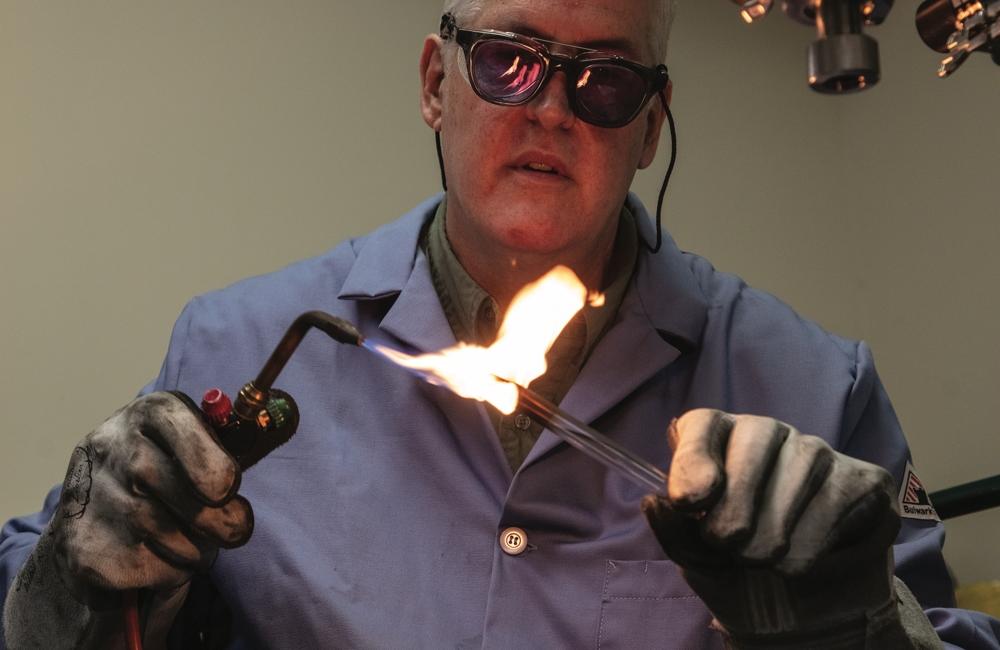ORNL materials processing researcher Mike Zach. Image credit: Carlos Jones, ORNL
Stable isotopes require expert handling before they go to end users.
A researcher ordering an isotope may need it in any one of a wide variety of forms, such as a tiny foil, a coin-sized plate, a short wire, or a cylinder made to excruciatingly precise specifications.
Converting an isotope from a powder to that final form is an intensive, multi-stage process that may require specialized equipment, high temperatures, highly toxic and corrosive chemicals, oxygen-free environments and days of laborious manipulation.
And, to make the job even more of a challenge, the isotope itself is likely to be extremely precious. The rarest of these isotopes, once they have gone through a very specialized enrichment process, are far more valuable than gold.
Under the circumstances, then, it’s no wonder that researchers want them delivered ready to use rather than having to fabricate the isotopes themselves.
That’s where ORNL’s Stable Isotope Group comes in. Experts in the group use extensive knowledge and specialized equipment to fabricate stable isotopes, ensuring these enormously valuable resources are used with minimal waste.
“My job is to take and transform any of the enriched stable isotopes into whatever form a researcher needs to make their project successful,” said ORNL materials processing researcher Mike Zach. “That can entail making thin films, wires or special little forms, or they may need us to press it into a cylinder that is very exacting—within 20 microns in diameter and length, for instance, and within 99.5 percent of the theoretical density.
“I will work with the researchers to figure out what their experiment requires, then I’ve got to figure out how to do it.”
The current inventory of stable isotopes was created in the calutrons at the Y-12 nuclear weapons plant near ORNL, but the calutron facility was shut down in 1998. New facilities are under development at ORNL to get American production of stable isotopes back up to speed; at most, only a few grams of most isotopes will be produced per year.
As a result, there will still be little room for waste, and researchers from around the world will still need Zach and his ORNL colleague Eva Hickman to make these materials into their final form. From ORNL’s labs, they go to researchers in areas such as medical research, national security and fundamental science.
The materials are stored in a variety of chemical forms—oxides, fluorides and metals—and working with them often means converting those chemical forms.
So if, for example, the isotope is a rare earth metal oxide, Zach or Hickman must make it react with highly corrosive, highly toxic hydrogen fluoride gas, heating it to more than 700 degrees Celsius—or nearly 1,300 degrees Fahrenheit. Once it is converted to a fluoride, a second chemical reaction uses calcium metal at over 1,000 degrees Celsius (more than 1,800 degrees Fahrenheit) to remove the fluorine and reduce it to an elemental metal. Depending on the task, several more separation steps may be needed to purify the metal.
In many cases, the isotope gets melted into a small bead and rolled out to the required thickness—a process that can take days. In other cases, Zach or Hickman creates a wire or cylinder by casting the melted isotope in a small mold.
The cost of the isotopes, which are housed on site, and the variety of forms they eventually take make for a unique work environment, Zach said.
“I really do have one of the most interesting jobs in the world. I sometimes say that my day starts off accessing a room the size of an office cubicle that contains one third of a billion dollars’ worth of inventory—and from that point on, my day just starts getting weird.”


